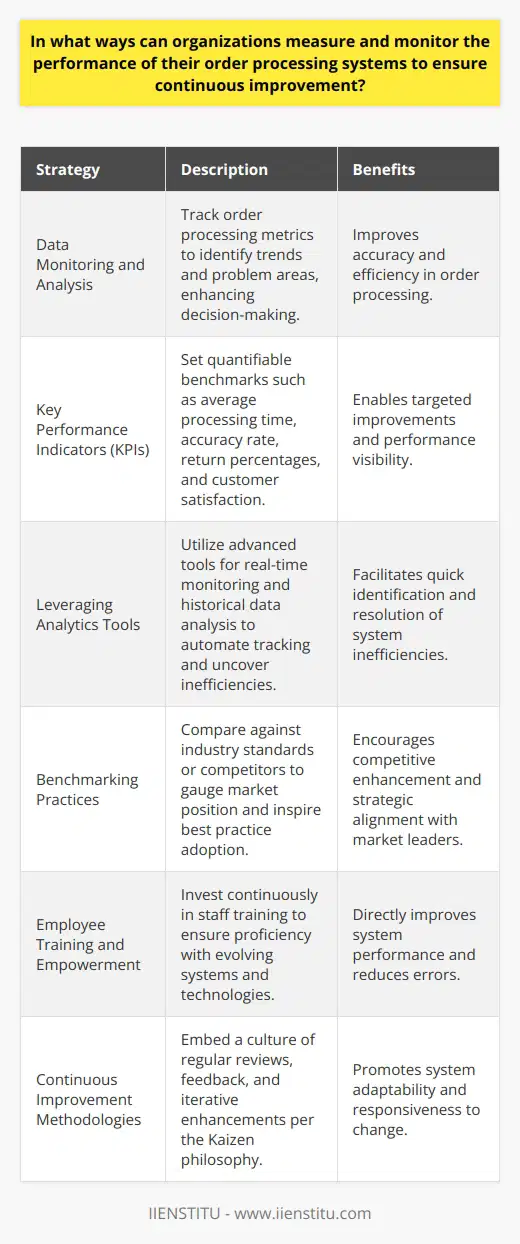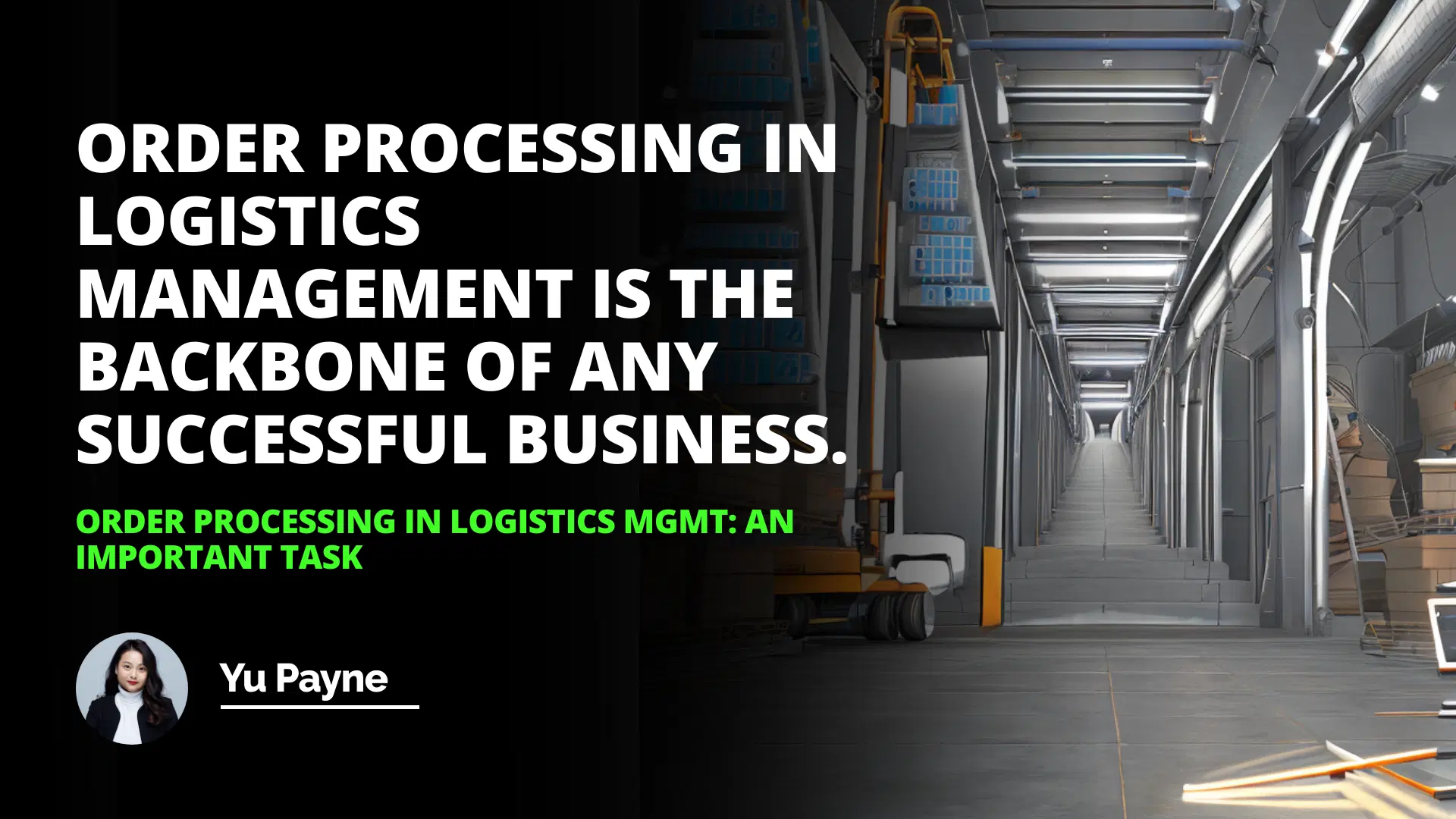
Imagine ordering a product online and eagerly waiting for its arrival, only to find out days later that it's been delayed due to some unforeseen processing hiccup. Frustrating, isn't it? I remember the time when I ordered a crucial part for my bike. The weather was perfect for cycling, and I was itching to hit the trails. But due to some complicated order processing, my part arrived weeks later, dampening my enthusiasm and causing a fair bit of inconvenience.
Introduction
The Importance of Order Processing in Logistics Management
The Steps Involved in Order Processing
The Impact of Slow and Complicated Order Processing
Conclusion
This simple experience made me appreciate the intricate dance that is order processing in logistics management. It's not just about taking an order and shipping a product; it's about ensuring the entire process is streamlined, efficient, and tailored to meet customer expectations. Let's dive deeper into why order processing is so vital, the steps involved, and how slow processing can have a ripple effect on both businesses and customers.
The Heartbeat of Logistics: Understanding Order Processing
At its core, order processing is the backbone of any logistics operation. It's the sequence of actions that a company undertakes from the moment a customer places an order to the point of delivery. This includes verifying, approving, and tracking orders from both customers and suppliers. Think of it as the central nervous system of the supply chain, transmitting information and ensuring every part functions harmoniously.
When I worked with a local logistics company, I saw firsthand how crucial an efficient order processing system was. We handled everything from small, individual orders to large, bulk shipments for corporations. Any delay or mistake in processing could lead to significant setbacks, lost revenue, and unhappy customers.
Why is Order Processing So Important?
Order processing isn't just a routine administrative task. It's an essential legal document between the buyer and the supplier, incorporating all the critical details:
Product descriptions and specifications
Pricing and payment terms
Delivery schedules
Taxes and commercial terms
This document sets the stage for the entire supply chain management process. If any detail is overlooked or mishandled, it could lead to delays, legal complications, or even loss of trust between parties.
Moreover, efficient order processing directly impacts the order cycle time – the duration from when an order is received to when the product is delivered to the customer. A shorter cycle time often translates to higher customer satisfaction, which is paramount in today's competitive market.
The Step-by-Step Journey of an Order
Understanding the steps involved in order processing can shed light on its complexity and importance. Here's a breakdown:
1- Order Verification: Once an order is received, it's crucial to verify all the details. This includes checking for any deviations from agreed terms, confirming prices, payment methods, and delivery dates.
Order processing in logistics management is the backbone of any successful business.
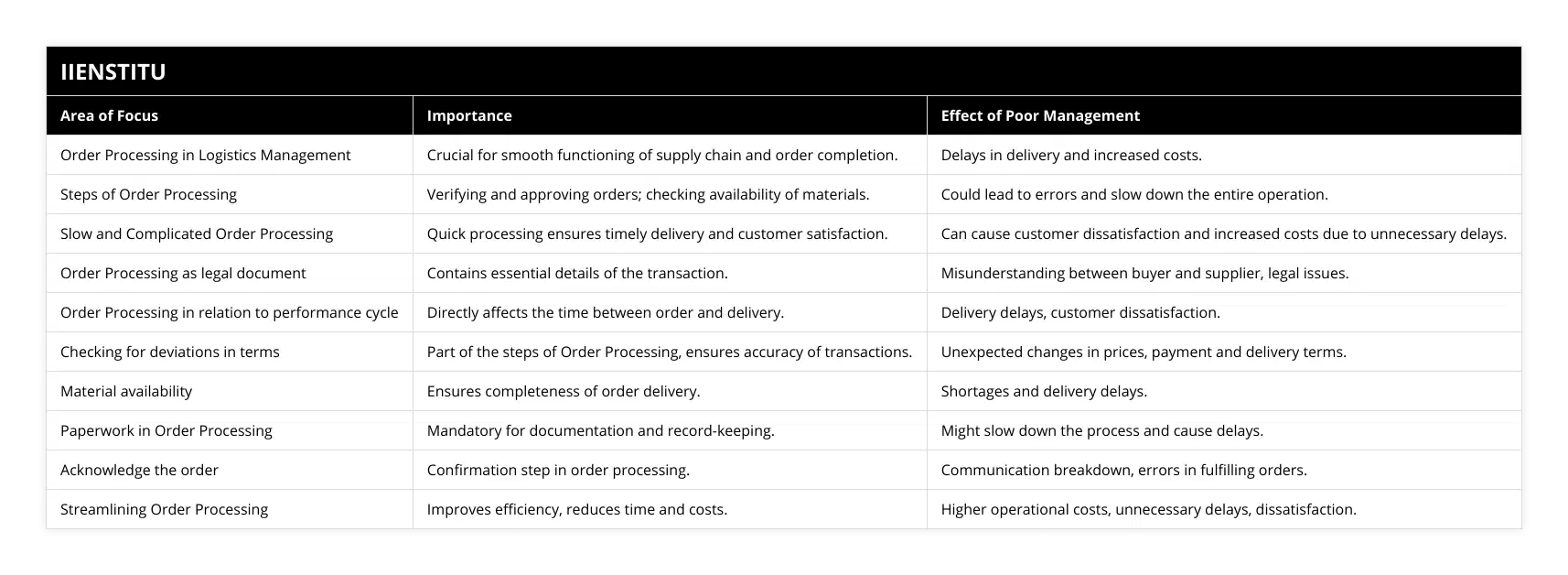
2- Inventory Check: Before confirming the order, the company must ensure that the requested items are in stock. If they're not, this step involves scheduling production and procuring necessary materials.
3- Order Approval and Acknowledgment: After verification and inventory checks, the order is approved. The customer is then sent an acknowledgment, detailing any modifications or confirmations.
4- Order Fulfillment: This involves picking, packing, and preparing the product for shipment. It's the physical aspect of order processing.
5- Shipping and Delivery: Arranging the logistics for transporting the product to the customer's location, ensuring timely and safe delivery.
6- Post-Delivery Service: After the product reaches the customer, post-delivery support and services are provided as needed.
Each step is interlinked, and a delay or error in one can affect the entire process.
The Importance of Streamlining These Steps
In my previous role, we faced a significant challenge: our order processing system was outdated, heavily reliant on paperwork, and prone to human error. Orders would sometimes be misplaced, leading to delays and frustrated customers. Recognizing the need for change, we decided to optimize our supply chain management process.
We invested in a modern order processing system that automated many tasks. The results were almost immediate:
Order cycle times reduced by 30%
Inventory management improved, reducing stockouts
Customer satisfaction scores increased
This transformation taught us that streamlining order processing isn't just beneficial—it's essential for staying competitive.
The Domino Effect of Slow and Complicated Order Processing
When order processing is slow or complicated, the impacts can be far-reaching:
Customer Dissatisfaction: Delayed orders lead to unhappy customers, negative reviews, and potential loss of future business.
Increased Costs: Inefficiencies often mean higher operational costs due to overtime, expedited shipping, or handling returns.
Strained Supplier Relationships: Delays can affect not just customers but also suppliers, leading to strained relationships and possible contractual issues.
Competitive Disadvantage: In a market where speed and reliability are key, companies with sluggish order processing fall behind more agile competitors.
I recall a time when a major client threatened to cancel their contract with us due to repeated delays. Our order processing system was bogged down by manual approvals and redundant checks. It was a wake-up call. We had to rethink our processes and make necessary changes.
The Culprits Behind Slow Order Processing
Several factors contribute to inefficient order processing:
Excessive Paperwork: Reliance on physical documents slows down communication and increases the chance of errors.
Lack of Automation: Manual data entry and processes are time-consuming and error-prone.
Poor Communication: Disconnected departments or lack of clear communication channels can lead to misunderstandings.
Inefficient Inventory Management: Not knowing what's in stock can delay order approvals and fulfillment.
Strategies to Streamline and Optimize Order Processing
So, how can companies optimize their supply chain management process tips to ensure efficient order processing? Here are some strategies:
1- Embrace Automation: Implementing software solutions that automate order entry, verification, and tracking can significantly reduce processing times.
2- Integrated Systems: Ensure that all departments—from sales to warehouse to shipping—are connected through an integrated system for seamless communication.
3- Employee Training: Regular training ensures that staff are proficient with the systems in place and understand the importance of their role in the process.
4- Inventory Management Solutions: Utilizing inventory management software helps in real-time tracking of stock levels, reducing delays due to stockouts.
5- Customer Communication: Keeping customers informed at every stage enhances transparency and builds trust.
6- Continuous Improvement: Regularly reviewing and refining processes helps in identifying bottlenecks and implementing solutions promptly.
In our company, after facing the challenges, we adopted an Enterprise Resource Planning (ERP) system. This move integrated all our processes, from order entry to inventory to shipping. The benefits were evident—we reduced errors, improved efficiency, and could scale operations smoothly.
Real-Life Examples of Efficient Order Processing
Let's look at some companies that have mastered the art of order processing:
Amazon: Known for its lightning-fast fulfillment, Amazon's sophisticated order processing system allows for same-day deliveries in many areas. They've optimized every step, from the moment you click "buy" to when the package arrives at your door.
Zara: This fast-fashion retailer has a supply chain that can move from design to store shelves in mere weeks. Their efficient order and production processes allow them to respond quickly to fashion trends.
The Human Element in Order Processing
While technology plays a significant role, the human element cannot be overlooked. Employees who are engaged, trained, and motivated contribute immensely to the efficiency of order processing.
I remember one of our team members, Lisa, who always went the extra mile. She noticed patterns in order delays related to a specific supplier. By bringing this to management's attention, we could address the issue directly, leading to faster processing times.
Empowering Employees
Empowering staff to make decisions, suggesting improvements, and taking ownership of their roles fosters a proactive culture. It's not just about systems and processes; it's about people working together towards a common goal.
The Future of Order Processing in Logistics Management
With advancements in technology, such as Artificial Intelligence (AI) and Blockchain, the future of order processing looks promising:
AI and Machine Learning: Predictive analytics can forecast demand, optimize inventory levels, and identify potential delays before they occur.
Blockchain Technology: Enhances transparency and security in transactions, ensuring all parties have access to real-time, immutable data.
Robotics and Automation: From automated warehouses to drone deliveries, the physical aspects of order processing are becoming faster and more efficient.
Companies that embrace these technologies are likely to stay ahead of the curve, offering superior service and agility.
Conclusion: Putting It All Together
Order processing is more than just a cog in the logistics machine—it's the heartbeat that keeps the entire operation alive and thriving. By ensuring this process is streamlined, efficient, and customer-focused, businesses can not only meet but exceed customer expectations.
Reflecting on my own experiences, both as a consumer and a professional, the importance of order processing in logistics management is crystal clear. Whether it's waiting for that bike part or managing a team handling thousands of orders daily, the goal remains the same: deliver the right product, to the right place, at the right time.
By optimizing supply chain management processes and embracing both technological and human solutions, companies can pave the way for sustained success and customer loyalty.
References
1- Chopra, S. (2019). Supply Chain Management: Strategy, Planning, and Operation. Pearson Education.
2- Rushton, A., Croucher, P., & Baker, P. (2017). The Handbook of Logistics and Distribution Management. Kogan Page Publishers.
3- Grant, D. B., Trautrims, A., & Wong, C. Y. (2017). Sustainable Logistics and Supply Chain Management. Kogan Page Publishers.
4- Mentzer, J. T. (2004). Fundamentals of Supply Chain Management: Twelve Drivers of Competitive Advantage. Sage Publications.
5- Christopher, M. (2016). Logistics & Supply Chain Management. Pearson UK.
Frequently Asked Questions
What are the key steps involved in order processing in logistics management?
Logistics management is an integral part of the supply chain that involves the coordination of goods and services from the point of origin to the end of consumption. Order processing is a critical part of logistics, which consists in receiving, managing, and fulfilling customer orders. This article explores the key steps involved in order processing in logistics management.
The first step in order processing is to receive orders from customers. This includes verifying the customer information, such as their address and payment method, and ensuring that the order is accurate and complete. Once the customer order is confirmed, the order information is entered into the system for tracking and processing.
The second step in the order processing process is to manage the order. This involves verifying the inventory levels, ensuring that the items are in stock, and ensuring that the items are shipped promptly. This step also includes tracking the order, monitoring its progress, and resolving customer service issues.
The third step in the order processing process is to fulfill the order. This involves packing and shipping the order and tracking it until it is delivered. It also consists of processing any returns or refunds and resolving any customer service issues.
The fourth step in the order processing process is to report and analyze the order. This involves tracking the order throughout the supply chain, exploring the order data to identify trends and customer preferences, and writing the charges to customers and stakeholders.
Order processing is an essential part of the logistics process. By understanding the key steps involved in order processing, businesses can ensure that orders are processed efficiently and effectively.
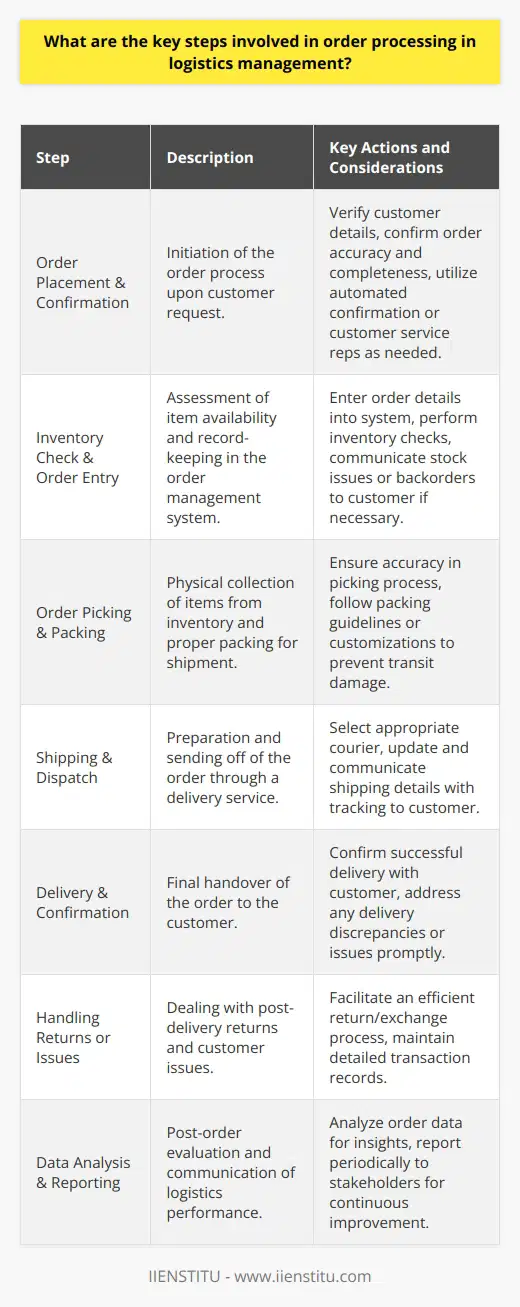
How does slow and complicated order processing impact the overall logistics process?
The logistics process is essential to a successful business, as it ensures that goods and services are efficiently delivered to customers. However, slow and complicated order processing can significantly impact the overall logistics process, resulting in increased costs and decreased customer satisfaction.
Order processing is the first step in the logistics process, as it involves collecting, analyzing, and verifying customer orders. If orders are processed slowly, it can lead to delays in delivering goods and services to customers. This can result in customers canceling their orders, reducing sales and customer dissatisfaction. Additionally, slow order processing can lead to increased costs due to the need to re-process orders or compensate customers for the inconvenience.
The complexity of order processing can also affect the overall logistics process. If orders are complicated and require manual intervention, they can take longer to process, thus leading to delays. Additionally, orders that require manual intervention can be more prone to errors, resulting in incorrect orders being sent to customers. This can result in increased costs due to re-processing the demand and compensating the customer for the inconvenience.
To ensure a smooth and efficient logistics process, it is essential to ensure that orders are processed quickly and accurately. To do this, businesses should ensure that their order processing system is up-to-date and efficient and that orders are processed according to standard procedures. Additionally, companies should ensure that their order processing staff are adequately trained to minimize errors.
In conclusion, slow and complicated order processing can significantly impact the overall logistics process, resulting in increased costs and decreased customer satisfaction. To ensure a smooth and efficient logistics process, businesses should ensure that orders are processed quickly and accurately and that their order processing staff are adequately trained.
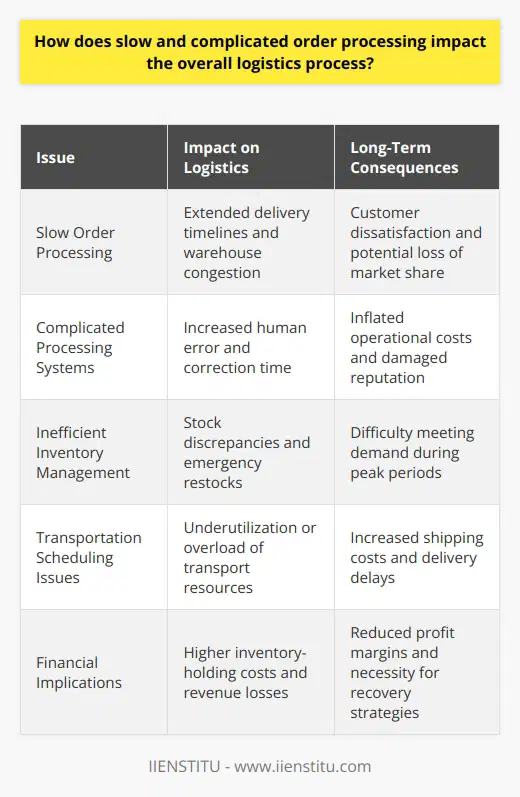
What strategies can be implemented to ensure efficient order processing in logistics management?
In logistics management, order processing efficiency is critical to a successful and profitable operation. To achieve this, several strategies can be implemented.
Firstly, an automated order processing system can significantly reduce the time and effort necessary for manual processing. In addition, automated systems can be tailored to the business's specific needs, ensuring the accuracy and timeliness of orders.
Additionally, an integrated warehouse management system can help streamline the entire process, from receiving orders to dispatching them. This will result in increased accuracy, improved customer service, and decreased errors.
Another critical strategy for efficient order processing is establishing clear communication protocols between departments. This includes providing clear instructions for staff and ensuring that everyone involved in the order processing process is aware of their responsibilities and has access to the necessary resources. Additionally, implementing a quality control system can help ensure that orders are processed correctly and that any discrepancies or problems are quickly identified and addressed.
Finally, implementing a tracking system can provide visibility into the order processing process. This allows businesses to monitor orders in real-time and quickly respond to any changes or issues. Additionally, tracking can provide valuable data on customer orders, which can be used to reduce processing time and improve customer service.
In conclusion, efficient order processing is vital to an effective and profitable logistics management operation. By utilizing automated order-processing systems, establishing clear communication protocols, and implementing tracking systems, businesses can ensure that their order-processing processes are efficient and effective.
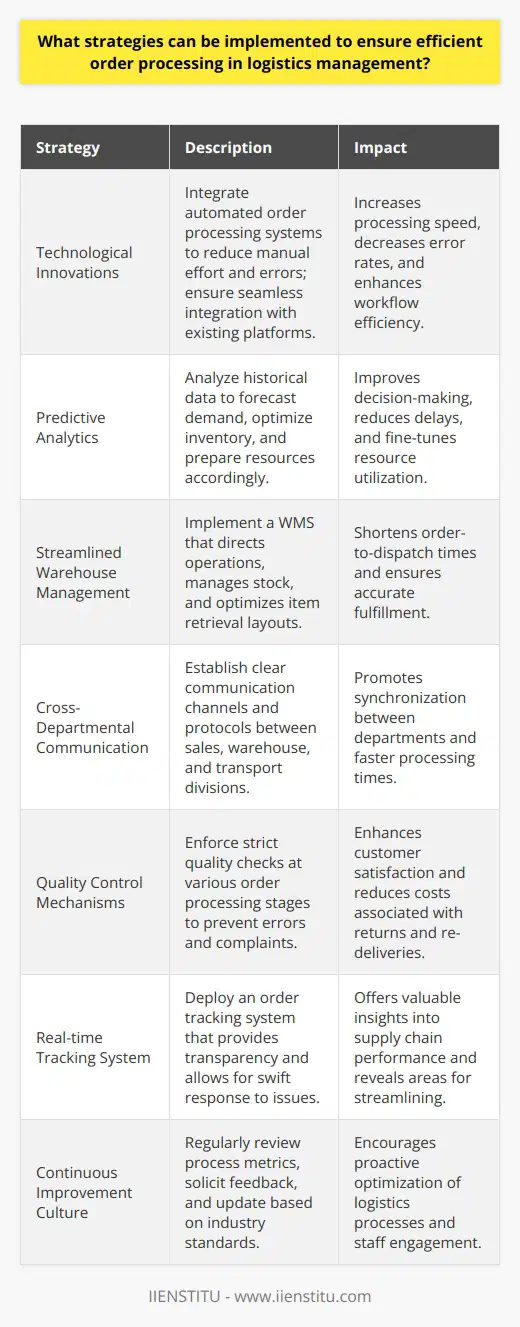
Why is order processing important in logistics?
Order Processing: The Backbone of Logistics
Order processing, a foundational component of supply chain management, is essential for the successful execution of logistics tasks. By systematically managing the receipt, analysis, and fulfillment of customer requests, order processing drives efficiency and customer satisfaction while ensuring the smooth operation of a business's logistical processes.
Optimizing Workflow Efficiency
An effective order processing system increases workflow efficiency, which in turn reduces errors, minimizes shipment delays, and lowers operational costs. By leveraging automation and adopting streamlined processes, businesses can quickly and accurately handle large quantities of orders, supporting seamless supply chain operations.
Improving Customer Satisfaction
The timeliness and accuracy of order processing significantly impact customer satisfaction. Quick and accurate order fulfillment ensures customers receive their desired products promptly, fostering trust and loyalty. Additionally, effective communication about order status and tracking information builds customer confidence in the company, contributing to long-term business success.
Enhancing Resource Management
Proper order processing enables businesses to appropriately allocate resources. Accurate demand forecasting and inventory management help prevent overstocking and understocking, ultimately reducing carrying costs and improving cash flow. Moreover, strategic resource allocation minimizes warehousing expenses and contributes to the overall efficiency of the logistics network.
Integrated Communication and Collaboration
The order processing stage encourages collaboration and communication within the logistics network. By sharing critical information with suppliers, transporters, and other stakeholders, businesses can optimize the entire supply chain process to facilitate better coordination and improve overall performance. Effective interaction also addresses potential issues proactively, mitigating risks and enabling smooth operations.
Supporting Scalability and Growth
An efficient order processing system is crucial for a company's growth and scalability. By implementing scalable solutions, businesses can respond to rapid changes in order volume and complexities without sacrificing efficiency or customer satisfaction. Stable and adaptable order management systems enable organizations to expand and compete globally while maintaining logistical excellence.
Contributing to Sustainability
Efficient order processing plays a role in enhancing a company's sustainability efforts. Minimizing transportation costs, reducing energy consumption, and optimizing inventory levels are all benefits of an effective order management process, contributing to overall environmental responsibility.
In conclusion, order processing is a critical component of logistics, impacting workflow efficiency, customer satisfaction, resource management, and more. By implementing effective order processing strategies, businesses can drive scalable growth while maintaining customer satisfaction, streamlined operations, and sustainable practices.
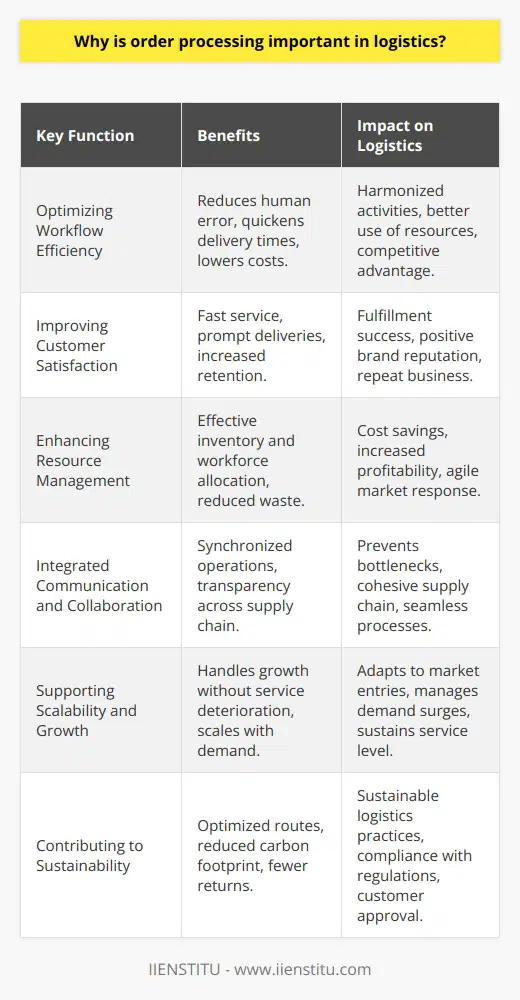
What is order processing in logistics and how does it differ from other business processes?
Order Processing in Logistics
Order processing is a crucial component of logistics, which involves the reception, management, and shipment of customer orders. It serves as a link between the customer and the supply chain, ensuring customer orders are accurately fulfilled and delivered in a timely manner. This process is essential for achieving customer satisfaction and maintaining efficient operations within a business.
Differences from Other Business Processes
There are several aspects that distinguish order processing in logistics from other business processes, such as procurement, production, and marketing. Firstly, order processing is focused on the customer, whereas other processes often prioritize the organization or its suppliers. This customer-centric approach ensures that businesses effectively meet customer needs and expectations.
Efficiency and Accuracy
Another key difference is the emphasis on efficiency and accuracy within order processing. In contrast to other processes that may allow for some variability or errors, order processing demands precise management to guarantee that products are correctly shipped to the customers. Any errors in the order processing can lead to increased costs, damaged reputation, and loss of customer trust.
Technological Integration
Technological integration is another factor that sets order processing apart from other business processes. Order processing software, Electronic Data Interchange (EDI), and Warehouse Management Systems (WMS) are often utilized to manage and automate the entire process. The integration of these technologies allows for increased efficiency, reduced human errors, and improved communication between customers, vendors, and different departments within the organization.
Inventory Management
Finally, order processing plays a significant role in inventory management. While other business processes may generate demand for products, order processing actually fulfills these demands by executing the transfer of goods from warehouses to customers. This process ensures that inventory levels are maintained at optimal levels, preventing stockouts or overstocking.
In conclusion, order processing in logistics is a vital component that positively impacts a company's overall supply chain performance. Its customer-centric approach, emphasis on efficiency and accuracy, technological integration, and inventory management roles set it apart from other processes within the business environment. As such, businesses must pay careful attention to their order processing systems to guarantee smooth, error-free operations and to maintain high levels of customer satisfaction.
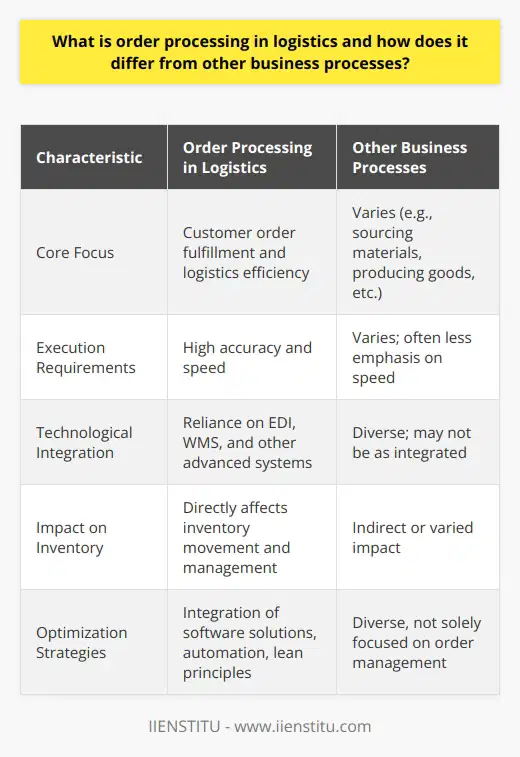
What are the main tasks involved in order processing in logistics operations and how can companies optimize them for maximum efficiency?
Order Processing Tasks in Logistics Operations
In the realm of logistics, order processing is crucial for delivering products to customers in an efficient and timely manner. The main tasks involved in this process include order reception, order entry, inventory allocation, order packaging, and shipping. Each of these tasks plays a significant role in determining the overall efficiency of the logistics operation.
Order Reception
The initial step in order processing is receiving the customer's order, which requires accurate order taking and confirmation. This involves documenting the required product information, such as item descriptions, quantities, and shipping details. Companies can optimize this task by employing digital tools, such as electronic order forms and automated email confirmations, to reduce errors and expedite the process.
Order Entry
Once the order is received, it must be entered into the company's order management system. This crucial step ensures that customer specifications, billing and shipping addresses, and payment information are appropriately recorded. Utilizing automation technology and integrating the order management system with other software platforms, such as inventory and customer relationship management systems, can significantly improve accuracy and efficiency in this task.
Inventory Allocation
Allocating inventory involves confirming product availability and reserving items for the customer's order. Monitoring inventory levels in real-time and employing comprehensive inventory management software can streamline this process, minimizing delays and stockouts while maximizing order fulfillment rates.
Order Packaging
Packaging orders is a vital step in preparing products for shipment to customers. Companies should continuously evaluate their packaging techniques, materials, and procedures to minimize waste, reduce costs, and improve sustainability. Leveraging automation technology and personnel training can optimize packaging efficiency and accuracy, ultimately resulting in cost savings and increased customer satisfaction.
Shipping
The final task in order processing is shipping the packaged order to the customer. Efficient shipping practices involve selecting the appropriate carrier, determining the most cost-effective and time-sensitive shipping option, and providing tracking information to the customer. Companies can optimize this process by partnering with reliable carriers, leveraging volume discounts, and utilizing transportation management software to assist in carrier selection and tracking.
In conclusion, optimizing order processing tasks in logistics operations can yield significant efficiency gains, cost reductions, and operational enhancements. By employing modern technology, evaluating procedures, and prioritizing customer service, companies can streamline their order processing procedures and ensure maximum efficiency in their logistics operations.
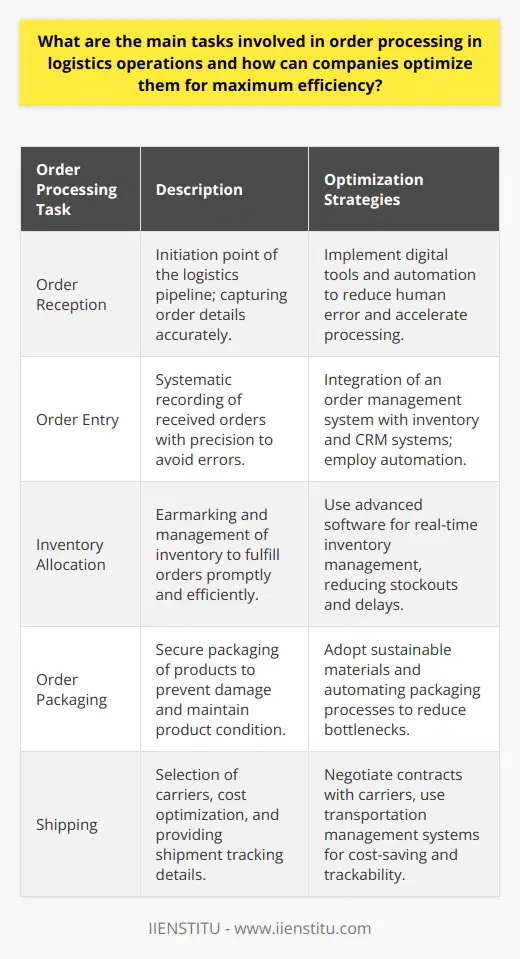
What is the role of order processing in logistics?
Role in Supply Chain Management
Order processing plays an integral part in the field of logistics and supply chain management, serving as the bridge between customer demand and product delivery. As customers place their orders, the order processing system tracks these requests, generating a detailed record of the items to be delivered and other essential information. This collection of data enables companies to streamline their operations, better predict customer needs, and improve overall service.
Streamlining Storage and Dispatch
Effective order processing is crucial for the efficient management of warehouse inventory, ensuring that each product can be easily located and dispatched. Prompt and accurate order processing permits businesses to reduce storage costs and optimize the arrangement of their warehouses, expediting the time needed to fulfill customer orders. This speed and accuracy of order processing are vital in maintaining a high level of customer satisfaction and facilitating repeat business.
Data Collection and Forecasting
Order processing can be leveraged as an essential tool in data collection and analysis, offering valuable insights into customer preferences and trends. By systematically collecting data concerning customers' purchasing patterns and preferences, companies can refine their supply chain strategies and predict future demand more accurately. Accurate forecasting enables companies to minimize stockouts and overstock situations, thereby optimizing inventory management and maintaining customer satisfaction.
Coordination of Transportation
As the main link between company operations and customer delivery, order processing plays a significant role in coordinating transportation and ensuring that products reach their intended recipients timely and efficiently. By processing orders efficiently, companies can consolidate orders and optimize load capacities, directly impacting transportation costs. This increased efficiency in transportation management can lead to reduced fuel consumption and emissions, presenting both financial and sustainability benefits for businesses in the logistics sector.
In conclusion, order processing plays a pivotal role in logistics, contributing to the efficient management of warehouse inventory, transportation, and overall supply chain operations. By utilizing efficient order processing techniques, businesses can ensure that their supply chains operate smoothly, allowing them to better serve their customers and maintain a competitive edge in the market.
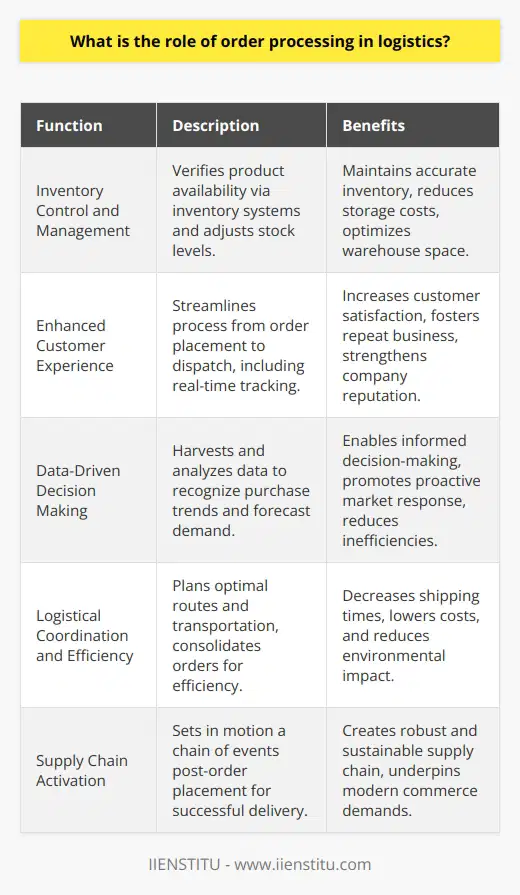
Why is order processing an important part of customer service?
Significance of Order Processing in Customer Service
Efficient Management of Transactions
Order processing plays an integral role in customer service, as it is a critical component in managing business transactions and ensuring customer satisfaction. This entails the accurate recording and tracking of orders from the initial placement until the final delivery and payment. A streamlined order processing system not only minimizes errors but also allows businesses' to meet client expectations and maintain long-term relationships.
Contribution to Customer Experience
Another aspect highlighting the importance of order processing is its contribution to the overall customer experience. A smooth, error-free process not only reflects the company's professionalism and reliability but also provides customers with a sense of security and trust, knowing their orders are handled promptly and efficiently. Consequently, an effective order processing system can lead to increased customer loyalty and enhance a company's reputation.
Timeliness and Accuracy
Promptness and precision are essential factors in successful order processing, as customers place significant value on receiving their goods and services in a timely and accurate manner. Supervising order fulfillment efficiently is vital for businesses to retain a competitive edge and ensure customer satisfaction. By developing and maintaining a robust order processing infrastructure, companies can ensure that their customers' demands are met while maintaining an orderly workflow within the company.
Inventory Management Impact
Efficient order processing also has a direct impact on inventory management. By accurately tracking and recording customer orders, businesses can effectively manage their stock levels and reduce instances of overstocking or stockouts. Proper inventory control enables companies to respond promptly to customer needs, facilitating a seamless purchasing experience and contributing to overall customer satisfaction.
In conclusion, integrating an efficient order processing system is vital for businesses aiming for optimal customer service. By minimizing errors, ensuring timeliness, and contributing to effective inventory management, businesses can benefit from an enhanced customer experience and improved overall reputation in the market.
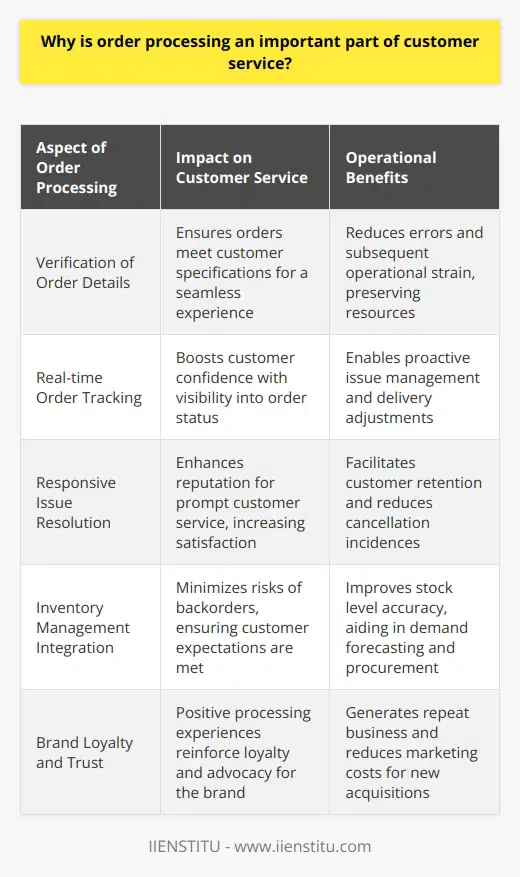
What are the 4 key processes in logistics?
Processes in Logistics: Planning, Implementation, Control, and Improvement
One core process: Planning
Logistics planning entails the formulation of strategies and outlines for the movement and storage of goods within a supply chain. It involves the identification of the most efficient routes and modes of transportation, as well as the determination of optimal inventory levels and storage requirements to meet customer demands.
Second key process: Implementation
Implementation involves the execution of the plans developed during the planning stage. It includes the procurement of resources, such as vehicles and warehouse equipment, and overseeing the coordination of transportation and storage activities. This process ensures that goods are moved and stored in a timely and cost-effective manner, complying with regulatory requirements and meeting customer expectations.
Third crucial process: Control
The control process is essential for monitoring and managing logistics operations. It involves evaluating key performance indicators (KPIs) to assess the effectiveness and efficiency of transportation, storage, and related processes in the supply chain. By analyzing data and tracking progress, companies can identify areas that require corrective actions and implement necessary changes to optimize their logistics performance.
Fourth vital process: Continuous Improvement
Finally, continuous improvement is a key process in logistics that emphasizes the ongoing identification and implementation of enhancements to supply chain operations. It comprises the adoption of innovative technologies, advanced analytics, and best practices to streamline and optimize logistics processes. Through continuous improvement, businesses can become more agile and responsive, achieving increased customer satisfaction and sustainable growth in a competitive market.
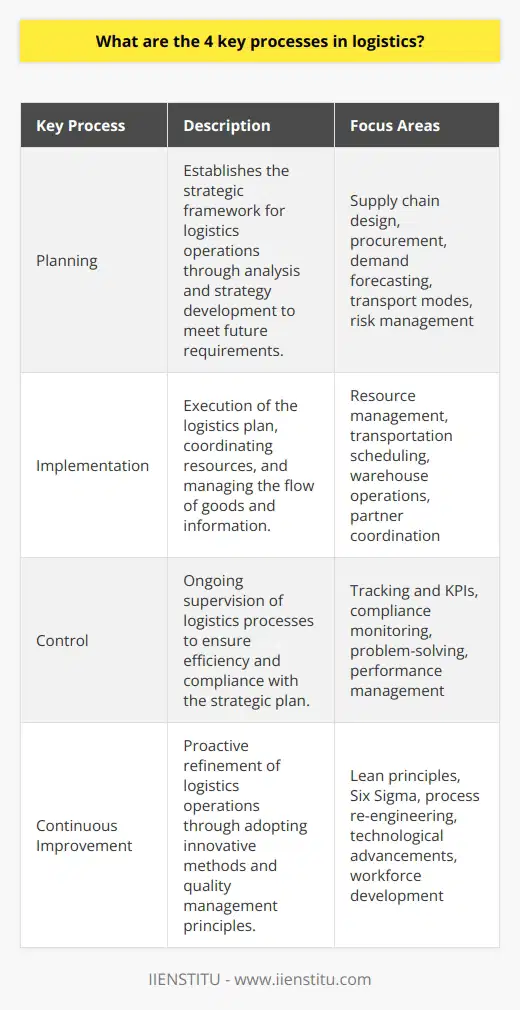
What is the importance of order processing in facilitating seamless customer experiences?
Order Processing Importance
Order processing occupies a pivotal role in securing seamless customer experiences. Proper order processes ensure the accurate and timely fulfillment of customer demands. It is indispensable for customer satisfaction and retention, two key parameters of business success.
Efficient Systems
The efficiency of the system directly corresponds to customer satisfaction. An efficient order process swiftly translates customer orders into organized instructions for order fulfillment. It acts as a vital link between purchasing behavior and delivery experience, fostering customer satisfaction.
Accuracy in Order Processing
Order processing accuracy underpins satisfactory customer experiences. A single mistake can lead to wrong product delivery, causing customer dissatisfaction. This can negatively affect a business' credibility and customer retention rate.
Increased Business Profitability
Order processing also holds significance in elevating business profitability. Efficient and accurate order processes reduce overall operational costs, enhance customer loyalty, and increase repurchase rates.
Customer Experience Enhancement
Order processing is key to enhancing customer experience. Customers appreciate swift, efficient, and accurate responses to their orders. A superior customer experience significantly contributes to higher customer loyalty and repeat purchases.
Conclusion
In conclusion, order processing is a crucial aspect of facilitating seamless customer experiences. Its efficiency, accuracy and role in business profitability, and enhancing customer experience demarcate its importance in the successful running of businesses.
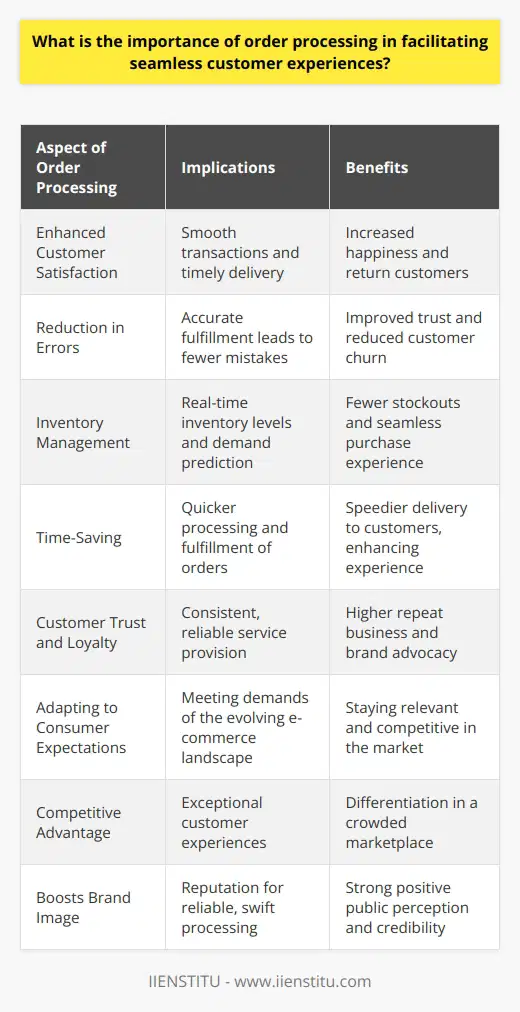
How does effective order processing contribute to the overall success and profitability of a business?
Effective Inventory Management
Effective order processing significantly contributes to a business's success and profitability. Firstly, it helps in inventory management. Timely order processing ensures a consistent supply of products. This stability eliminates the chances of stock-outs. Hence, it supports uninterrupted sales and secures steady revenue.
Boost Customer Satisfaction
Secondly, effective order processing affects customer satisfaction. Prompt processing of orders leads to faster deliveries. This enhanced efficiency not only satisfies existing customers but also attracts potential ones. Consequently, it results in customer retention and an increase in the customer base, both of which are critical for profitability.
Enhanced Operational Efficiency
Thirdly, effective order processing promotes operational efficiency. Quick order processing reduces the time products spend in the warehouse. This swift movement lowers holding costs. The reduction in expenditure translates into increased profits. Also, these efficient operations result in fewer errors, saving the costs associated with rectifying mistakes.
Improved Business Intelligence
Lastly, efficient order processing provides valuable insights into the business. It generates important statistics about sales trends, fast-selling items, and customer behavior. Leveraging this intelligence, businesses can make informed decisions. These can include adjusting pricing strategies, enhancing the marketing approach, or increasing the range of fast-moving products. These data-driven decisions will enhance the business's profitability.
To sum up, effective order processing is indispensable for a business's success and profitability. It aids in the management of inventory, boosts customer satisfaction, enhances operational efficiency, and contributes to improved business intelligence. Emphasizing an efficient order processing system can therefore significantly augment a business's bottom line.
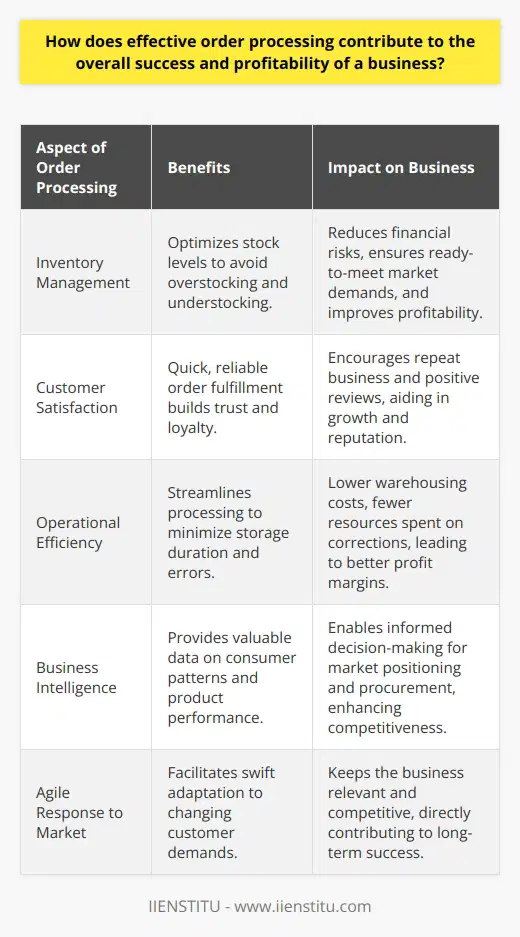
How can advancements in technology and automation improve efficiency and accuracy in order processing tasks?
Technological Improvement in Order Processing
Advancements in technology and automation facilitate substantial enhancements in order processing tasks. These advancements provide precise and efficient methods that restrains human errors. This happens because, in an automated system, computers control, execute, and monitor all tasks, eliminating human intervention.
Precision and Accuracy
Automation increases accuracy in order processing by reducing the risk of human error. For instance, automated input systems validate data, thereby preventing incorrect or incomplete entries. This leads to improved accuracy in documentation and ordering.
Increased Efficiency
Automation also boosts efficiency, allowing tasks to be completed rapidly and continually. Instead of humans manually inputting orders, automation systems assist in swift order processing. This results in saved man-hours, increased productivity and reduced costs.
Superior Order Tracking
Such technologies support superior order tracking. Online systems update data in real time, offering instantaneous access to order information. This ensures transparency, enabling companies to monitor progress and rectify any issues swiftly.
Improved Customer Service
Improved efficiency and accuracy also heighten customer service. Swift, reliable order processing leads to increased customer satisfaction, improved retention rates and potentially, heightened sales.
In summary, advancements in technology and automation drive efficiency and accuracy in order processing. This has a ripple effect, positively impacting everything from internal processes to customer service. Consequently, embracing these advancements is not an option, but a necessity for modern businesses.

What are the main challenges faced in optimizing order processing for logistics management?
Order Processing Optimization Challenges
Inefficient Systems
The primary challenge in order processing optimization is inefficient systems. Logistic managers often deal with outdated software that can't keep up with large amounts of data. This inefficiency leads to delays in order processing, affecting customer satisfaction and overall business performance.
Complexity of Operations
Logistics management is usually complex involving multiple variables such as inventory management, transportation, and warehousing. Optimizing such multifaceted processes is an uphill task due to the sheer scale and interdependence of these operations.
Data Accuracy
Ensuring data accuracy is another challenge. Information errors at any point in the order processing could corrupt entire datasets, thus influencing decision-making and strategic planning.
Lack of Real-Time Transparency
There is also a lack of real-time transparency. Without the necessary visibility in operations, it is tough to quickly identify and solve bottlenecks in order processing.
Human error and Training
Finally, human error and lack of proper training are also significant hurdles. Team members unfamiliar with new systems can slow down processes, making optimization efforts counterproductive.
Optimum order processing for logistics management is indeed a challenging task. A comprehensive approach that addresses system upgradation, process simplification, data accuracy, transparency, and training is vital in tackling these challenges. It is essential to remember that successful optimization is a continuous process and not a one-time exercise.

How do efficient order processing systems impact inventory management and control in logistics operations?
Improving Order Accuracy and Speed
Efficient order processing systems positively impact inventory management and control in logistics operations. They improve order accuracy, thereby reducing the occurrences of errors, cancellations, and returns.
Increase Inventory Rotation and Reduce Holding Costs
They also enhance speed in order processing, leading to quicker inventory rotation. The faster the inventory rotation, the lower the holding and carrying costs incurred. This significantly reduces the overall operational costs, optimizing the profitability of the business.
Enhancing Data Accuracy for Better Decision Making
These systems also enhance inventory control by providing accurate and real-time data. Accurate data facilitates effective decision-making, especially in procurement and stock control processes. Timely decisions ensure that the company consistently maintains an optimal inventory level.
Optimizing Space Utilization
Moreover, efficient order processing systems often facilitate the optimization of warehouse space. Products are organized according to demand. High demand products are easily accessible, reducing the cycle time. This process allows logistic operations to utilize the warehouse space effectively, thereby saving costs associated with warehouse management.
Conclusion
In conclusion, efficient order processing systems are essential in logistics operations. They enhance inventory management and control by improving order accuracy, increasing inventory turnover, providing accurate data for decision making, and optimizing space utilization. Therefore, investing in efficient order processing systems should be a priority for any business aiming to optimize its logistics operations.
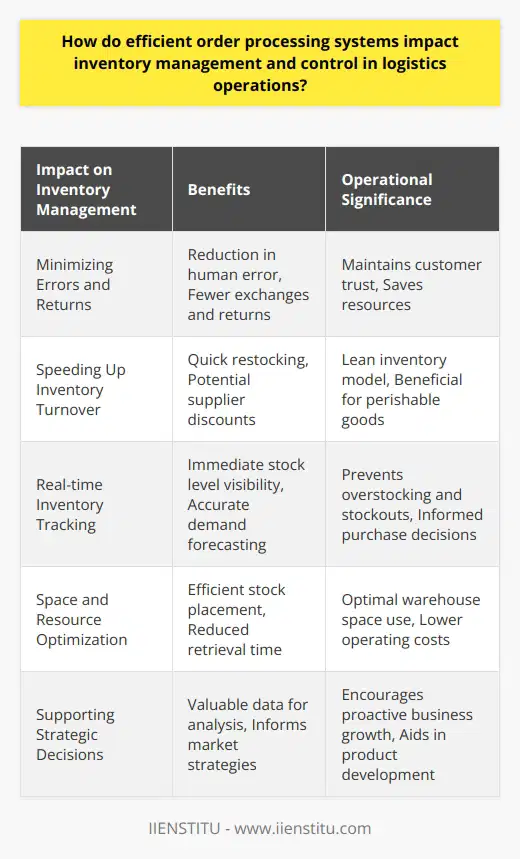
In what ways can organizations measure and monitor the performance of their order processing systems to ensure continuous improvement?
Data Monitoring
Organizations can monitor the performance of their order processing systems in different ways. Regular data collection is one of the most basic methods. Firms should monitor their rates of processed orders, mistaken orders, and late deliveries. They should also routinely collect customer feedback.
Key Performance Indicators
Organisations can measure system performance using Key Performance Indicators (KPIs). KPIs might include order cycle times, order accuracy rates, and cost per order. They provide quantitative benchmarks to guide improvements.
Analytics Software
The use of analytics software allows organizations to visualize their order processing system operations. This can help highlight bottlenecks and inefficiencies. Real-time tracking of orders also falls under this strategy.
Benchmarking
Benchmarking with industry standards or competitors provides another method of measuring performance. This involves comparing the performance of the organization's system with that of its industry peers. It can highlight areas for potential improvement.
Training
Organisations must also keep their teams up to speed with new system improvements. Training is an ongoing process, and the information gathered from the above methods can guide its direction. It ensures that staff are equipped to manage the order processing system effectively.
Continuous Improvement
Finally, companies should set up a system for continuous improvement. This involves making ongoing changes based on the metrics and feedback gathered. These changes should focus on increasing efficiency, reducing errors, and improving customer service within the order processing system.
In conclusion, organizations can use various methods to measure and monitor the performance of their order processing systems. From data monitoring and benchmarking to training and continuous improvement, each strategy plays an important role in enhancing the system's efficiency and effectiveness.
